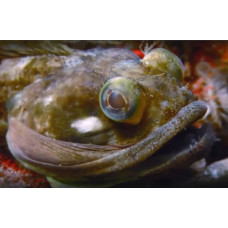Latin name
Neoclinus blanchardi
Other name
Neoclinus blanchardi
Identification
The species name is given in honor of Dr. S. B. Blanchard, who first discovered this species and sent a specimen to the French biologist Charles Frédéric Girard, who described it.
The body of the Sarcastic Fringehead is long, slender and compressed. The upper jaw is very large, especially in adult males, where it is longer than the head. The eyes are large. There are less than 15 gill stamens. There are 21-25 scales on the lateral line.
Features of fish fins
They have a long dorsal fin that extends from the nape of the neck to the rounded caudal fin. The anal fin extends from the excretory opening to the base of the caudal fin. Two eyes are prominent on the barbs of the dorsal fin, the anterior eye between the first two spines and the posterior eye between the sixth and ninth spines. The dorsal and anal fins work in conjunction with the pectoral fins and tail during forward motion. They swim fast and furious, moving randomly over short distances, constantly changing direction.
Fish colouring
The coloration of living individuals of this species is dull brown with a slight reddish tinge. There are pale green spots near the back. The dorsal fin has green and pink spots. The edge of the fin is bluish-white. The two eyes on the dorsal fin are metallic blue and turn black within a narrow, bright golden yellow ring. The caudal fin is dirty green with green and red stripes along the edge.
Distribution
Widespread in the eastern Pacific Ocean off the coast of North America, from San Francisco to Baja California.
Habitat
Subtropical marine benthic species. Occupies depths from 3 to 73 m. Juveniles stay at shallower depths (14-25 m) than adults (25-60 m).
Size
Sarcastic fringehead maximum body length is 30 cm. Adult length is over 11 cm, usually 15-19 cm. Maximum reported age: 6 years.
Behavior
Aggressive fish. Usually found along the open coast, on sandy or hard muddy bottoms at low tide, less often in bays. They live inside objects, especially clam shells, clam burrows, and bottles. Most of the time they are dormant, with only their heads exposed from their burrows. They will defend their shelters from invading enemies, regardless of size. When other fish invade the occupied territory, they pull aside their gill covers, open their huge mouths, and display their needle-like teeth.
Food and feeding habits
The Sarcastic Fringehead is an omnivorous predator. It consumes 13.6 times its body weight in food. It is an ambush predator, leaping from its hiding place to chase prey and grabbing moving prey with its sharp needle-like teeth. It is not known which organisms it prefers to eat in the wild.
Reproduction
Sarcastic fringehead spawn on the bottom in coastal habitats. Females lay eggs in abandoned clam burrows, under rocks, in beer cans and other containers. Eggs are small, ranging from 0.9 to 1.5 millimeters in size. Each egg looks like an oil globule and is attached to the nest and other eggs by special threads. A female will lay about 3000 eggs. The males guard the eggs until the fry hatch.
Fishing
This species is of no commercial interest in the fishery.
Relationship with a person
Harmless.
| Classification | |
| Phylum | Chordata |
| Class | Actinopterygii |
| Squad | Blenniiformes |
| Family | Chaenopsidae |
| Genus | Neoclinus |
| Species | N. blanchardi |
| Features | |
| Conservation status | Least Concern |
| Habitat | Pelagic |
| Life span, years | 6 |
| Maximum body weight, kg | No information |
| Maximum length, cm | 30 |
| Sailing speed, m/s | No information |
| Threat to people | Not edible |
| Way of eating | Predator |
Sarcastic fringehead
Tags: sarcastic fringehead



